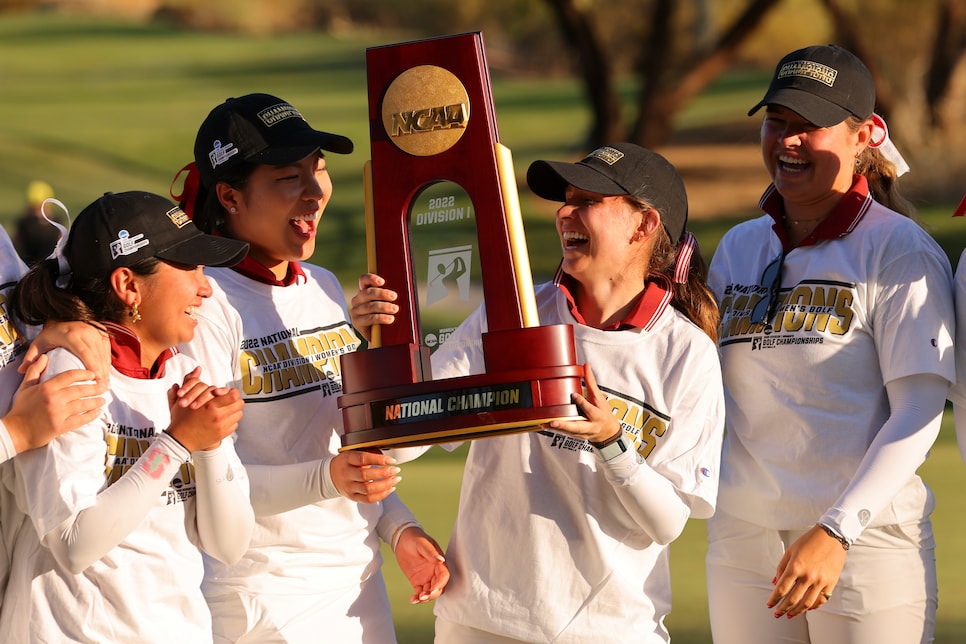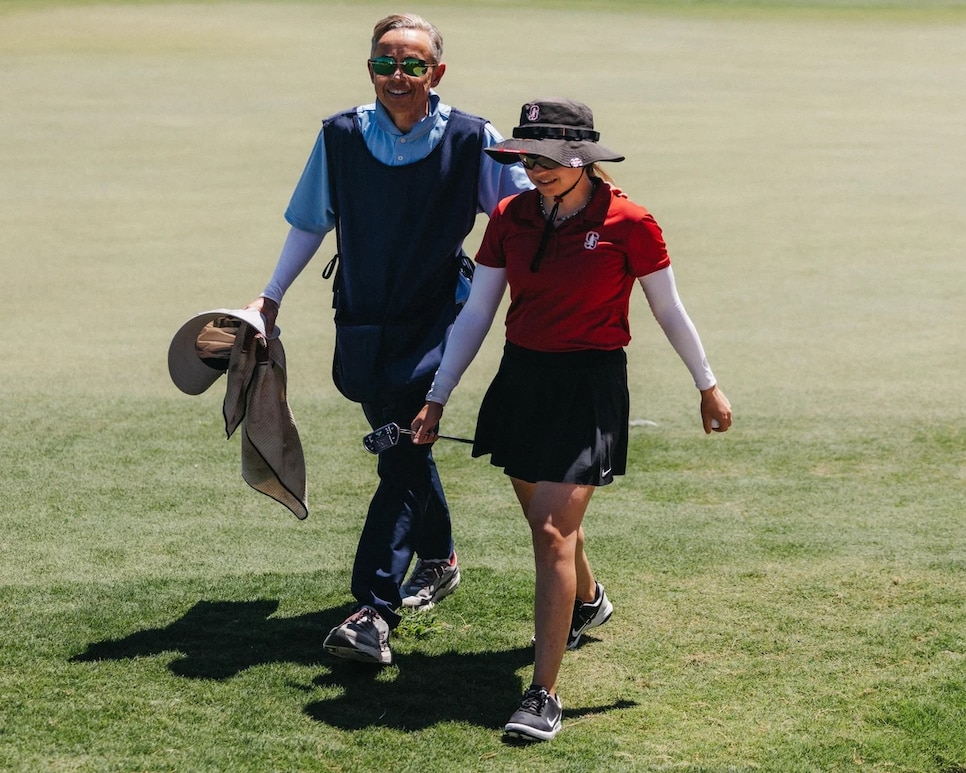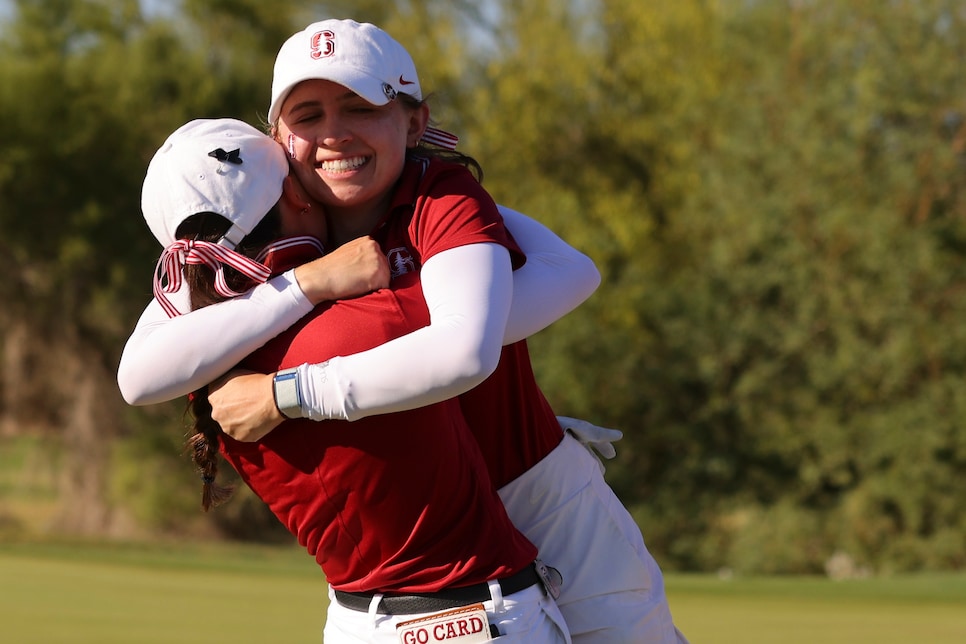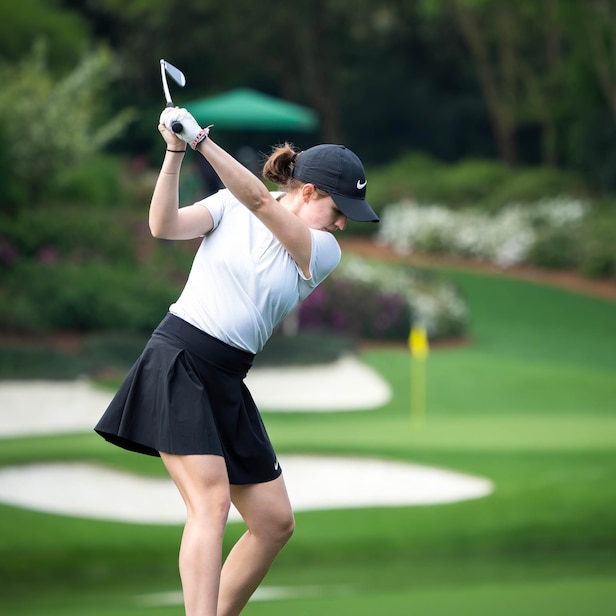In the walk from the practice range to the first tee on that late March day in 2023, a feeling of dread began to rise in Brooke Seay. This was the Augusta National Women’s Amateur, one of the most coveted and prestigious invitations in golf, and Seay had forced herself to show up yet now was regretting it. “I was really excited to be playing,” she recalls, “but after that first warmup, I just knew that something was not right. I realized how much worse it was than I thought.”
The Stanford star was dizzy, nauseous and, most disturbing, her vision was blurry. She says that when she hit her first tee shot at Champions Retreat Golf Club in Wednesday’s opening round, she had to ask her caddie where the ball was because she couldn’t track it. Her vision eventually improved, but the rest of the competitive day was a blur. “I was just trying to get through it,” Seay says.
Seay, who 10 months earlier won all three of her matches in Stanford’s 2022 NCAA women’s national team title, shot the first round’s second-highest score of 82. The next day she improved a bit with a 77. She missed the cut for those who would compete in the final round at Augusta National on the weekend, but everyone in the field gets a Friday practice round on the famed Masters course.
Again, as Seay prepared to play, all of the uncomfortable sensations were coming back, and she wasn’t sure she should tee it up. This is Augusta—among the most rare and sought after golf experience in the world—so Seay pressed on, but she remembers at one point coming over to her family at the ropes and saying she wasn’t sure she could finish.
“I was stubbornly trying to take in that day and enjoy it,” Seay says. “But it was not as enjoyable as I wanted it to be or as I hoped it would be.”

Brooke Seay hits a shot into the 12th hole at Augusta National during a practice round at the Augusta National Women’s Amateur.
Gordon Seay
Seay climbed the hill at 18 that day, putted out in front of a handful of spectators, and walked into an uncertain future in her golf career—and, more concerning, her life. The only thing that was clear is that the myriad symptoms she was suffering from a second concussion suffered in a year were not going away anytime soon.
Today, at 24 years old and having just completed her master’s degree at Stanford in Epidemiology and Clinical Research, Seay is open to talking about the experience because she has made big strides in her recovery. In fact, she wants to discuss it, because she wants other people, whether they’re athletes or not, to understand that concussions and brain injuries can be life changing, and that taking care of yourself is immeasurably more important that any goal or endeavor.
It helps that Seay also has rediscovered significant pieces of her golf game that she thought might never come back. After more than three years of physical and emotional lows, she’s hopeful again.
In late July, with only a handful of competitive golf rounds played, Seay birdied the first hole of a playoff to win the 51st Arizona Women’s Amateur Championship, and the big prize for that victory was a berth in the U.S. Women’s Amateur that begins on Monday at Bandon Dunes. In a testament to how long Seay has been an elite amateur this will her eighth appearance—the most of any entrant in the 156-player field. She played in her first U.S. Women’s Am in 2015 at age 14, and Seay’s best finish was reaching the quarterfinals in 2021 at Westchester (N.Y.) Country Club.

Brooke Seay birdied the first playoff hole to wn the Arizona Women’s Amateur and qualify for the 2025 U.S. Women’s Amateur. (Photo by Camiren Huth/AZ Golf)
“I love this tournament, and it’s always been a highlight on my schedule,” Seay said on the phone from Stanford as she and her dad and caddie, Gordon, prepared to fly to Oregon. “My game is still not where I want it to be, but winning [in Arizona] gave me a lot of confidence that I can still play through imperfect golf—which is always true, but especially now.
“There were so many times over the last couple of years where I thought about just quitting golf, so it really means a lot to play in a high-level tournament.”
This week is meaningful, too, because Seay plans for it to be her farewell to amateur golf as she prepares to turn pro later this summer and enter LPGA Tour Q School in the fall. That path was not remotely a consideration at this time last year because Seay remained in the throes of symptoms of Post-Concussion Syndrome, which included almost daily migraine headaches.
Gordon Seay remembers Brooke being home from college at one point and trying to work on her game at the range. “It didn’t go well,” he says. “It was heartbreaking for me as a parent, seeing my child suffer. She was complaining of nausea, dizziness and vision issues, all while hitting relatively routine shots on the range, and we had to quickly stop. It was a distinctly sad moment.
“She had achieved a lot with golf before and here she was unable to even feel well—as a young woman, never mind hitting a golf ball.”
Brooke Seay recalls the circumstances of her concussions and calls them “silly” and “random” and “innocuous,” and if the consequences weren’t so dire, she could chuckle at her misfortune.
The first brain injury happened in January 2022 after Seay finished eating in a Stanford dining hall and was returning her dishes to a window. That opening had a metal frame, and Seay accidentally banged her forehead against it. “A clumsy, silly mistake, and I laughed it off,” she says. But a couple of days later Seay began to feel nauseous and dizzy, and she eventually reached out to her Stanford trainer. She was put through concussion protocols and told that it could take up to two weeks for her to recover. Nevertheless, Seay decided to attend a Curtis Cup practice session while trying to make the team—“which I probably shouldn’t have done.”
After that, Seay took about a month off, felt as if she had recovered, and that April, despite qualifying for her second ANWA at Augusta, she skipped it to compete in Chevron Championship, a LPGA major where she made the cut and was the low amateur. Her spring college season would be just as strong, with Seay having five top-10 finishes in six events leading up to Stanford capturing the national title. Seay was stellar in the match-play portion of the championship at Grayhawk Golf Club in Scottsdale, Ariz., as one of two Cardinal players to go undefeated.
“Brooke was amazing in 2022!” Stanford coach Anne Walker wrote recently in a text exchange while on a summer trip to Europe. “She is an outstanding player with an incredible ability to focus under pressure and execute. During our NCAA run in 2022, she was laser focused and unflappable in the face of immense pressure.”
‘I hope that if someone sees this story and does get a concussion or is going through something similar, that it’s helpful. When I met other people who’ve had similar experiences, it was so validating to hear that I wasn’t just making this up. So, I hope that I could be useful for someone else.’
Brooke Seay
There was one more important honor that Seay earned that championship week. She was selected for the NCAA’s Elite 90 award as the golfer with the top grade-point average among all of the competitors at the championships. That number was 4.0 in her major of Human Biology—a standard she maintained throughout her health struggles and into her master’s program, for which she’s currently completing a thesis titled, “Impact of Residential Pollution on Birth Defects in the Central Valley of California.”
Always self-driven to succeed in every facet of her life, Seay admits that attribute both helped and hurt her when she suffered the second concussion at Stanford almost exactly one year after the first.
Seay attended a Cardinal men’s volleyball match because she had friends on the team, and while the players warmed up and she wasn’t watching closely, a wayward ball came zipping into the stands and struck Seay in the head. The force knocked her back, she says, and she immediately worried about suffering another concussion. “I just started crying,” she says. “I was, like, I can’t do this again.”
Hours later, Seay says she started feeling symptoms similar to her first experience, but they quickly got worse. She says she barely slept in the first month, “and I was just completely exhausted.” Then the daily migraines started, and she figures they persisted for more than a year.

Brooke Seay holds the 2022 NCAA Championship trophy with her Stanford teammates.
C. Morgan Engel
In the aftermath of the concussion, she was shut down by the Stanford medical staff from practicing but still showed up to support her teammates as best she could. Seay retrieved balls and tossed them back during drills but paid the price later.
“I didn’t think it was going to be a problem,” she says, “but then I’d go back to my room and just feel like I had to throw up and need to lie down for an hour or two. The motion of bending down, of watching balls go back and forth, it was overstimulation for me. It doesn’t make sense, and it’s hard to understand if you’re not going through it.”
Meantime, Seay was being told by doctors that her symptoms would likely improve over time. When they didn’t, she says other treatments were tried, including vestibular therapy, neck strengthening exercises and nerve block shots. None of it seemed to provide much relief. “They said they’d never seen concussion symptoms last this long,” Seay says. “It didn’t give me a lot of hope.”
She made the decision to play in the 2023 ANWA that spring, but with the top-ranked Stanford team being led in the spring by the world’s top-ranked amateur female, Rose Zhang, and with numerous other strong players on the roster, Seay didn’t play a single competitive round for the Cardinal. The feeling of barely being a part of the team anymore began to take its toll.
“Even when I’d showed up for practice, it felt like I was more of an observer than part of the team,” Seay says. “For the tournaments away, I would watch leaderboards and text them. And at home I’d go to cheer them on. I don’t know … it was really hard to not have the thing that I’ve done for so long.”
Making it worse was that Seay wasn’t walking around in a cast on her arm or brace on her leg. No one could see her brain injury, and she wondered at times if some of those around her questioned if she was overdramatizing her injuries or simply wanted the time off.
“I definitely felt like my teammates were behind me, and they were trying to be supportive,” Seay says. “But I was always a little unsure if they really understood what was going on or how bad things were.”
Says Gordon Seay, “Brooke wanted to play golf. She was upset—not simply because she couldn’t play golf, but because she was away from the team, her good friends, and it was a change from what she had known. So, it wasn’t this refreshing and wonderful time for her.”

Brooke Seay walks with her dad and caddie, Gordon Seay, during the 2025 Arizona Women’s Amateur. (Photo by Camiren Huth/AZ Golf)
Then came a decision that surprised Brooke. As Stanford prepared for the 2023 NCAA Championship at Grayhawk, she was informed by Walker that she would be on the traveling roster as an alternate. Once there, Seay still didn’t expect to play, but when one Cardinal player struggled in the first round of stroke play, Walker told Seay she’d be playing the next day. “I felt a lot of pressure,” Seay says. “It was, like, ‘pick up some slack, we’re putting you in.’”
Loaded up with pain medication, she would end up playing the remaining five rounds of the tournament, and when Stanford reached the final eight for match play, Seay won her opening match in the Cardinal’s defeat of Pepperdine. She then lost in the semifinals and Stanford was beaten 3-1 by USC.
“That was the last time I competed at a high level in all of this concussion stuff,” Seay says.

Brooke Seay hugs Stanford teammate Aline Krauter after winning their matches against Oregon in the 2022 NCAA Championships.
C. Morgan Engel
Seay went home to San Diego that summer, and because of her continuing symptoms she struggled to maintain a practice routine or do much in her social life. As a now-graduate student, she was eligible to play for Stanford in the 2023-24 season, but in discussions with the university medical staff it was decided she would take the fall off. “When the doctor told me that. I felt like having the support of the people closest to me assured me that it was the right decision—that my brain was more important than one season of golf,” Seay says.
Come the spring, Seay wasn’t in condition to be a starting player, and in May 2024, at the Omni La Costa Resort & Spa in Carlsbad, Calif., just miles from where she grew up, Seay watched from the sidelines as the Cardinal again won the national title. She is credited with being on the team but didn’t hit a single competitive shot that season.
As proven by her academic success, Seay has a thirst for learning and knowledge, and she used that to both educate and advocate for herself during the recovery from her brain injury. She researched Post-Concussion Syndrome and found that some studies indicate women are more susceptible than men to suffer subsequent concussions and PCS, and experience more extensive symptoms. Not surprisingly, Seay wrote a paper about it.
“We didn’t realize the significant escalation in risk to the brain by having a secondary concussion in a relatively short period of time after the first concussion,” Gordon Seay says. “Had someone informed us of that, perhaps she would’ve made some different decisions along the way.”
He says he believes too many young athletes are encouraged to “toughen up” and get back to their sport as quickly as possible.
“I am certainly one who would say be tough about many things, but this isn’t one of them,” Gordon Seay said. “This is one that we have learned requires rest and recovery, because otherwise you are risking one’s long-term health.
“As a family we would love to get the word out to other athletes and parents and family members that it’s a critical to rest and recover the brain, which takes a significant period of time—often, many months before returning to one sport.”
The elder Seay also said his family does not want to point fingers for what Brooke went through, but he does strongly believe that anyone around a person who suffers a concussion—be it doctors, trainers, coaches, other athletes, friends, family members—should be better educated or have their knowledge refreshed to ensure that care for the injured person is optimal.
“Our mission is still one centered on education more than blame,” Gordon Seay says. “But in that process, it’s still important to be able to reflect back and constructively evaluate what we all did and how we could have done it differently.”
As this year progressed and Brooke began to feel better, she also could focus on encouraging and educating others who have suffered what she has.
“I hope that if someone sees this story and does get a concussion or is going through something similar, that it’s helpful,” she said. “When I met other people who’ve had similar experiences, it was so validating to hear that I wasn’t just making this up. So, I hope that I could be useful for someone else.”
Brooke says many of her symptoms are now gone and she only occasionally suffers migraine headaches, thanks to effective medication and treatment. But both she and her dad will tell you that she is not yet back, mentally or physically, to where she was before the concussions. She said that collecting her thoughts for writing is difficult at times and that she has trouble thinking of the right words in conversation.
“She’s not 100 percent,” Gordon Seay says. “There’s still an uphill climb both in navigating the system and continued improvement in her health.”
In golf, Brooke Seay once made a habit of qualifying for USGA events and competing in the U.S. Women’s Amateur. This week at Bandon Dunes, after the 3½ years she endured, it feels like something of a gift, though one she mostly fashioned with her own talent, drive and stubbornness.
“After I couldn’t play my last [college] season, I knew that I wanted to play again, to feel healthy and competitive,” Seay says. “Even if I didn’t play pro golf, I wanted to feel that I could end my golf career on my own terms.”
After what she’s been through, no one would argue Seay deserves that.
This article was originally published on golfdigest.com

